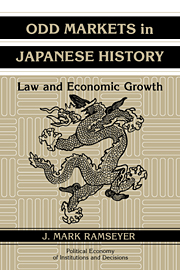Book contents
- Frontmatter
- Contents
- List of tables
- Series editors' preface
- Acknowledgments
- INTRODUCTION
- CHAPTER 1 LAW AND ECONOMIC GROWTH
- CHAPTER 2 PROPERTY: WATER AND LAND
- CHAPTER 3 EXTERNALITIES: SMOKE AND NOISE
- CHAPTER 4 MARKETS: CHILDREN
- CHAPTER 5 AUTONOMY: FAMILY LAW
- CHAPTER 6 PROMISSORY CREDIBILITY: SEX
- CHAPTER 7 CARTELS: COTTON SPINNING
- CHAPTER 8 CONCLUSIONS
- References
- Index
- POLITICAL ECONOMY OF INSTITUTIONS AND DECISIONS
CHAPTER 3 - EXTERNALITIES: SMOKE AND NOISE
Published online by Cambridge University Press: 21 September 2009
- Frontmatter
- Contents
- List of tables
- Series editors' preface
- Acknowledgments
- INTRODUCTION
- CHAPTER 1 LAW AND ECONOMIC GROWTH
- CHAPTER 2 PROPERTY: WATER AND LAND
- CHAPTER 3 EXTERNALITIES: SMOKE AND NOISE
- CHAPTER 4 MARKETS: CHILDREN
- CHAPTER 5 AUTONOMY: FAMILY LAW
- CHAPTER 6 PROMISSORY CREDIBILITY: SEX
- CHAPTER 7 CARTELS: COTTON SPINNING
- CHAPTER 8 CONCLUSIONS
- References
- Index
- POLITICAL ECONOMY OF INSTITUTIONS AND DECISIONS
Summary
INTRODUCTION
In any world where people cannot bargain with each other costlessly (which is to say, in any world that counts), a court that would promote efficient growth will need to resolve disputes over conflicting uses of property. Typically, it will face the problem when one person develops property in a way that lowers the value of the property next door. In Chapter 2, I discussed related issues in water use. Here, I turn to the problem of pollution.
Although observers sometimes suggest that the imperial Japanese government let entrepreneurs externalize the costs of their activity by polluting freely, the observers are wrong. Notwithstanding the many ambiguities in the law, the government did not let entrepreneurs freely pollute. Instead, if an entrepreneur harmed others through inefficient activity, the courts held the entrepreneur liable in tort. In the process, they necessarily encouraged efficient levels of growth.
To explore how imperial Japanese courts handled the externalities to industrial production, I first summarize the economics of pollution (Section 1; readers familiar with law & economics may safely skip to Section 2). I then explain Japanese tort law (Section 2), and discuss its implications for economic growth (Section 3).
LAW AND EXTERNALITIES
To explore the relation between pollution law and efficient growth, consider a simple example from Polinsky (1983: 16). Posit one factory F, one neighbor N, production volumes that range from o to 3 units per day, and hypothetical profits to F and harm to N given by Table 3.1.
- Type
- Chapter
- Information
- Odd Markets in Japanese HistoryLaw and Economic Growth, pp. 43 - 53Publisher: Cambridge University PressPrint publication year: 1996



